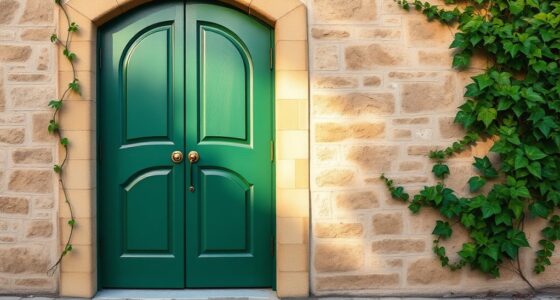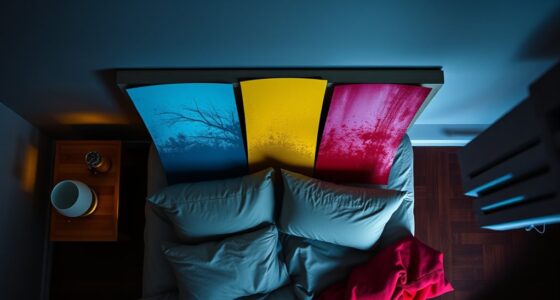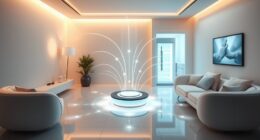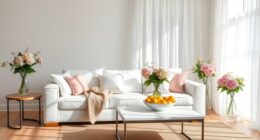Your favorite room color reveals a lot about your inner feelings and personality. For example, blue suggests you crave calm and mental clarity, while red indicates you thrive on energy and excitement. Green shows you value balance and peace, and beige reflects your desire for warmth and comfort. Yellow sparks your creativity, and purple hints at a desire for mystery and spiritual growth. Curious to uncover more about what your color choice says about you? Keep exploring deeper meanings behind each hue.
Key Takeaways
- Different colors evoke specific emotions and psychological responses, revealing your inner feelings and personality traits.
- Blue signifies calmness and trust, indicating a desire for peace and stability in your life.
- Red reflects energy and passion, suggesting you seek excitement or motivation.
- Purple symbolizes spirituality and wisdom, pointing to a connection with higher consciousness or a desire for mystery.
- Green and yellow reveal your need for balance, growth, optimism, and mental stimulation in your environment.
The Calming Power of Blue
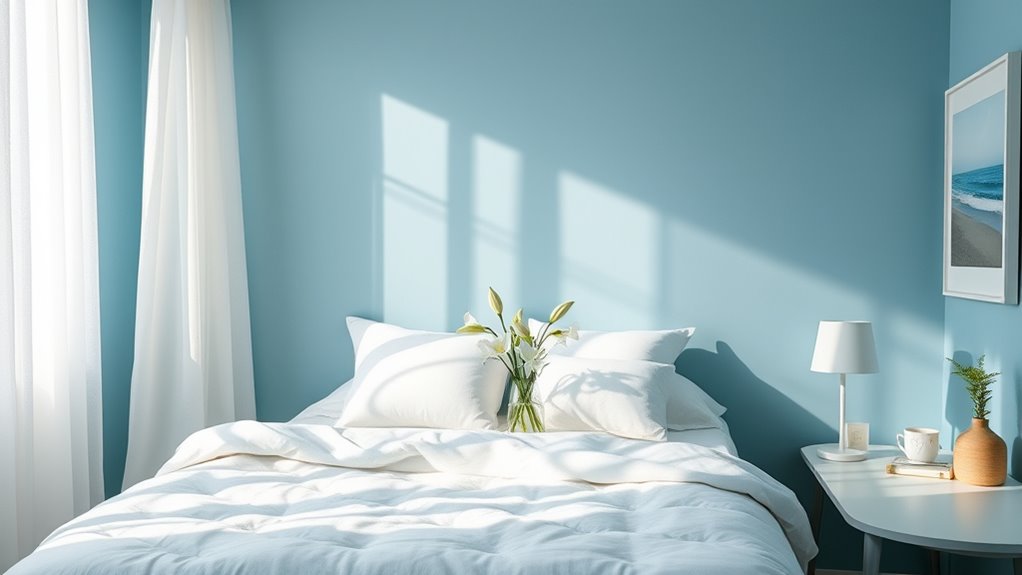
Blue is widely recognized for its calming effects, making it a popular choice for bedrooms and relaxation spaces. In color psychology, blue is linked to tranquility, trust, and stability, helping to reduce stress and promote peacefulness. When you choose blue for your interior design, you’re tapping into a trend that emphasizes serenity and mental clarity. Modern interior design trends favor soft, muted shades of blue that create a soothing environment without overwhelming the senses. This color encourages a sense of quiet and focus, perfect for unwinding after a busy day. Whether you opt for navy, sky blue, or pastel tones, incorporating blue into your space helps foster a calming ambiance that supports relaxation and emotional well-being. Additionally, understanding the emotional benefits of color can enhance your overall sense of balance and harmony in your living space.
The Energizing Effect of Red

Red naturally energizes your space, encouraging you to move more and stay active. It can raise your heart rate, making you feel more alert and motivated. If you want to boost your energy levels, incorporating red into your room might be just what you need. Additionally, choosing the right spray tips helps achieve a smooth, vibrant finish that enhances the room’s energetic feel.
Boosts Physical Activity
When you surround yourself with the color red, it can naturally increase your energy levels and motivate you to move more. This vibrant hue stimulates your senses, enhancing exercise motivation and creating an invigorating workout environment. Red’s energizing effect encourages you to be more active, making it easier to start and sustain physical activity. Consider incorporating red into your exercise space to boost enthusiasm and commitment. Here’s how red influences your activity levels:
| Red in Your Space | Impact on Physical Activity |
|---|---|
| Bright accents | Increases alertness |
| Red walls | Enhances motivation |
| Red accessories | Elevates energy |
| Overall ambiance | Promotes movement |
Using red strategically can transform your workout environment into a motivating, energetic space that drives you to move more.
Stimulates Heart Rate
Surrounding yourself with the color red doesn’t just boost motivation—it also directly influences your heart rate. When you’re in a red environment, your heart beats faster, heightening your alertness and energy levels. This increase in heart rate variability can make you feel more alive and ready to tackle tasks. The emotional impact of red is powerful; it triggers excitement and urgency, pushing you to act quickly. As your heart rate rises, your body releases adrenaline, sharpening focus and stimulating physical activity. Red’s energizing effect can help you break through fatigue and stay engaged, especially during high-pressure moments. So, if you need a quick boost, adding red to your space can energize your body and elevate your emotional state.
The Peaceful Vibe of Green
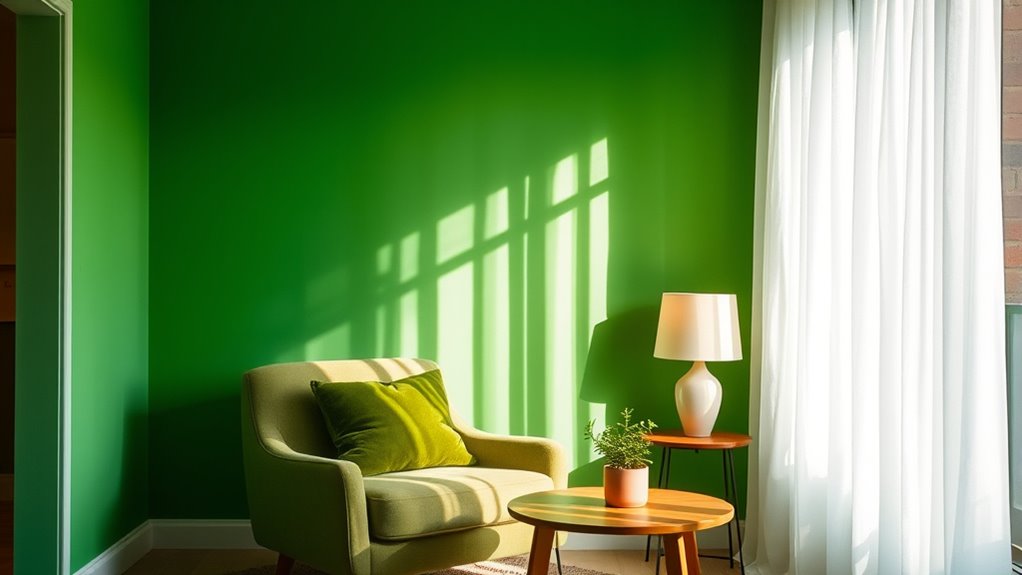
Green naturally evokes a sense of calm and balance, making it a popular choice for creating a peaceful atmosphere in any space. By using nature-inspired palettes, you bring the tranquility of the outdoors inside, helping to reduce stress and promote relaxation. Green’s soothing visual effects encourage a sense of harmony and renewal, making your environment feel more inviting and restful. Whether you choose soft sage or vibrant emerald, this color fosters a connection to nature that calms your mind. Its versatile shades work well in bedrooms, living rooms, or meditation spaces, enhancing your overall well-being. The peaceful vibe of green transforms your home into a sanctuary where you can unwind and find balance effortlessly.
The Warmth and Comfort of Beige
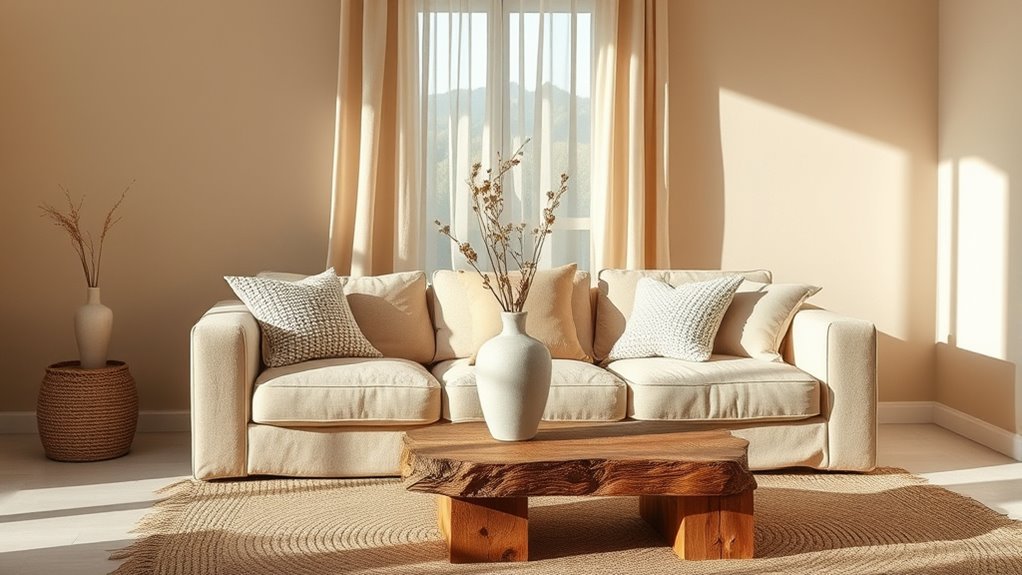
Beige instantly creates a cozy, inviting atmosphere in any room, making you feel right at home. Its versatile style blends easily with various decor choices, giving you endless design options. If comfort and adaptability matter to you, beige might just be your perfect color. Additionally, understanding security vs ethical hacking can help you appreciate the importance of safeguarding your personal space and privacy.
Creates Cozy Atmosphere
Because it naturally exudes warmth, beige creates a cozy atmosphere that invites relaxation and comfort. Its calming tone fosters a sense of safety, making your space feel inviting. This aligns with current home decor trends focused on creating tranquil environments. The psychological effects of beige include reducing stress and promoting mental clarity, helping you unwind after a busy day. To evoke emotion, consider this table:
| Feelings | Connection to Beige |
|---|---|
| Serenity | Promotes calmness |
| Security | Feels safe and stable |
| Comfort | Invites relaxation |
| Warmth | Enhances intimacy |
Additionally, choosing colors like beige can be influenced by interior design trends that emphasize creating inviting and peaceful spaces.
Versatile Style Choice
One of beige’s greatest strengths is its versatility, making it an ideal choice for various decorating styles and spaces. Its neutral tone easily complements different interior decor themes, from modern minimalism to classic elegance. Beige’s subtle warmth creates a welcoming atmosphere without overwhelming the senses. When considering color psychology, beige promotes feelings of calmness, stability, and comfort, helping you craft spaces that feel both refined and inviting. Whether you’re aiming for a sophisticated look or a cozy retreat, beige adapts effortlessly, allowing you to add accent colors or bold furnishings without clashing. Its timeless appeal ensures your space remains stylish over time. Choosing beige demonstrates an understanding of how color choices influence mood and ambiance, making it a smart, versatile option for any room.
The Creativity Spark of Yellow
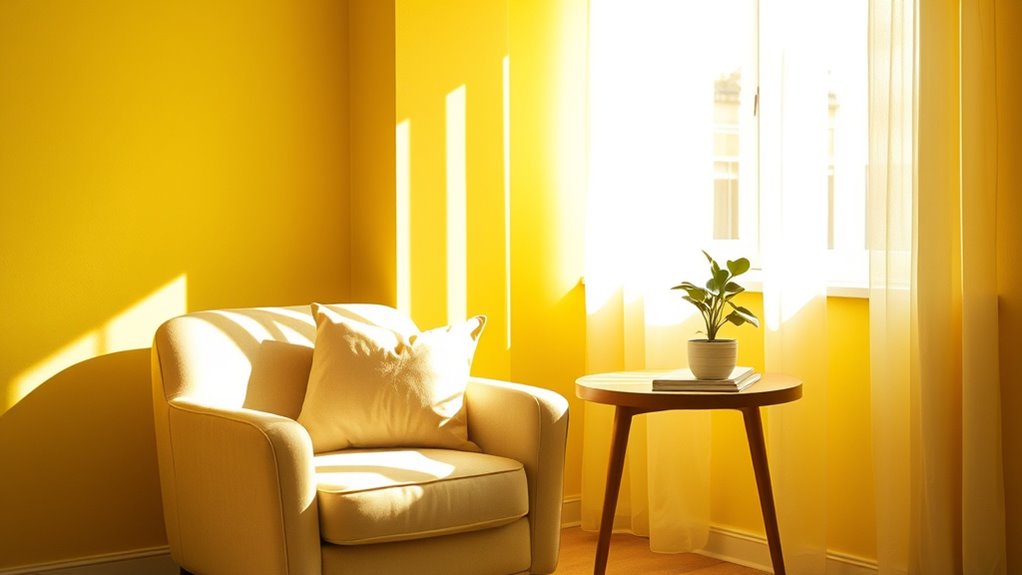
Have you ever wondered why yellow sparks your creativity? In color psychology, yellow is linked to optimism and mental stimulation, making it ideal for inspiring ideas. When used in room design, yellow can energize your space and boost your problem-solving skills. Here are four ways yellow enhances your creative vibe: 1. Stimulates mental activity and focus 2. Promotes positivity and openness 3. Encourages innovative thinking 4. Brightens the room, making it inviting for brainstorming. A well-chosen yellow shade can also improve your environmental awareness, helping you stay connected with your surroundings and nature.
The Mystique of Purple

What is it about purple that adds an air of mystery to any space? It’s the deep spiritual symbolism and regal elegance that make purple so mesmerizing. This color has long been associated with royalty, luxury, and wisdom, giving your room a sense of sophistication and depth. Purple invites introspection and creativity, making your space feel both enchanting and meaningful. Its mystique lies in its ability to evoke a sense of wonder and reverence, inspiring calm and reflection. When you incorporate purple into your environment, you’re not just choosing a color—you’re creating a sanctuary that radiates spiritual richness and regal charm. The aura associated with purple reflects spiritual growth and deep connections, further enhancing its allure. Purple’s allure transforms any room into a space of both mystery and majesty.
Frequently Asked Questions
How Does Room Color Influence My Mood Daily?
Your room color considerably influences your daily mood through psychological effects and color symbolism. Bright colors like yellow can boost your energy and optimism, while calming shades like blue help you relax and stay focused. Warm hues, such as red or orange, may increase excitement or appetite. Choosing colors thoughtfully can enhance your well-being, making your space a reflection of your desired emotional state and positively impacting your daily mindset.
Can Color Choices Affect Productivity in Workspaces?
Color choices profoundly impact your productivity in workspaces through the principles of color psychology. Bright, energetic hues like yellow and orange can boost enthusiasm, while calming shades like blue enhance focus and concentration. Thoughtful workspace design incorporates these colors to create an environment that fosters efficiency. By selecting colors aligned with your work goals, you can optimize motivation and reduce stress, ultimately improving your overall productivity in any workspace.
Do Cultural Differences Change Color Interpretations?
Did you know that cultural symbolism and regional preferences deeply influence how you interpret colors? When you see a color, its meaning varies across cultures—what’s seen as calming in one region might symbolize mourning in another. This shows that cultural differences profoundly change color interpretations, affecting everything from interior design to branding. So, your favorite color might hold different meanings depending on your background, shaping how you perceive and respond to it.
How Do Lighting Conditions Alter Perceived Color Meanings?
Lighting conditions considerably influence how you perceive color meanings. Lighting psychology shows that natural light enhances true colors, while artificial lighting can shift perceptions. Color temperature, measured in Kelvin, affects whether a room feels warm or cool, altering your emotional response. For example, warm lighting makes colors feel more inviting, whereas cool lighting can create a calming or sterile atmosphere. Adjusting lighting helps you change the mood and meaning of a space effortlessly.
Are There Health Impacts Associated With Certain Room Colors?
Like a gentle breeze calming a storm, certain room colors can influence your health. Bright reds and yellows may boost energy but cause stress or increased heart rates, while cool blues and greens promote relaxation, reducing anxiety. These colors trigger psychological effects and physiological responses that impact your mood and well-being. Choosing the right hues can support your mental health and even improve sleep, making your space healthier and more harmonious.
Conclusion
Now that you know the hidden stories behind your favorite colors, you might find yourself subtly drawn to certain shades. These hues gently whisper your inner desires and moods, guiding your space choices without you even realizing. Embrace their quiet influence, and let them softly shape your surroundings to reflect who you truly are. After all, your room’s colors are just gentle messengers, helping you create a sanctuary where your true essence can quietly flourish.


